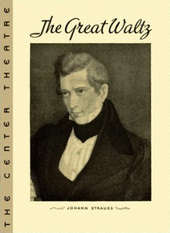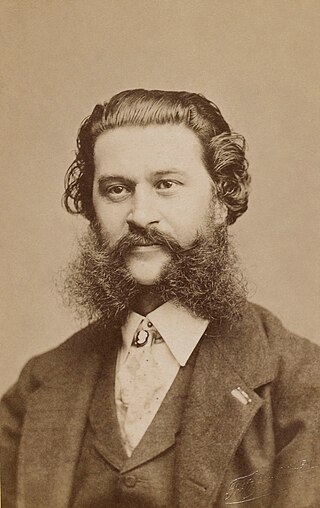
Johann Baptist Strauss II, also known as Johann Strauss Jr., the Younger or the Son, was an Austrian composer of light music, particularly dance music and operettas as well as a violinist. He composed over 500 waltzes, polkas, quadrilles, and other types of dance music, as well as several operettas and a ballet. In his lifetime, he was known as "The Waltz King", and was largely responsible for the popularity of the waltz in Vienna during the 19th century. Some of Johann Strauss's most famous works include "The Blue Danube", "Kaiser-Walzer", "Tales from the Vienna Woods", "Frühlingsstimmen", and the "Tritsch-Tratsch-Polka". Among his operettas, Die Fledermaus and Der Zigeunerbaron are the best known.
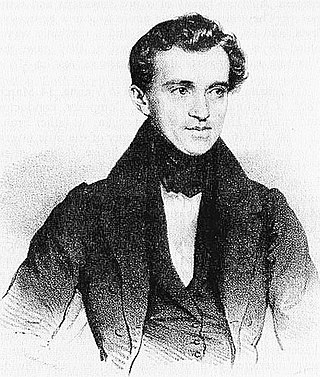
Johann Baptist Strauss I, also known as Johann Strauss Sr., the Elder or the Father, was an Austrian composer of the Romantic Period. He was famous for his light music, namely waltzes, polkas, and galops, which he popularized alongside Joseph Lanner, thereby setting the foundations for his sons—Johann, Josef and Eduard—to carry on his musical dynasty. He is best known for his composition of the Radetzky March.

"The Blue Danube" is the common English title of "An der schönen blauen Donau", Op. 314, a waltz by the Austrian composer Johann Strauss II, composed in 1866. Originally performed on 15 February 1867 at a concert of the Wiener Männergesang-Verein, it has been one of the most consistently popular pieces of music in the classical repertoire. Its initial performance was considered only a mild success, however, and Strauss is reputed to have said, "The devil take the waltz, my only regret is for the coda—I wish that had been a success!"
George Forrest was an American writer of music and lyrics for musical theatre best known for the show Kismet, adapted from the works of Alexander Borodin. He was also known professionally at times as Chet Forrest.
Robert Craig Wright was an American composer-lyricist for Hollywood and the musical theatre, best known for the Broadway musical and musical film Kismet, for which he and his professional and romantic partner George Forrest adapted themes by Alexander Borodin and added lyrics. Kismet was one of several Wright and Forrest creations that was commissioned by impresario Edwin Lester for the Los Angeles Civic Light Opera. Song of Norway, Gypsy Lady, Magdalena, and their adaptation of The Great Waltz were also commissioned by Lester for the LACLO. The LACLO passed most of these productions to Broadway.
Song of Norway is an operetta written in 1944 by Robert Wright and George Forrest, adapted from the music of Edvard Grieg and the book by Milton Lazarus and Homer Curran. A very loose film adaptation with major changes to both the book and music was released in 1970.

Marinka is an operetta by Hungarian composer Emmerich Kálmán with book by George Marion, Jr. and Karl Farkas, and lyrics by George Marion, Jr. The operetta is a retelling of the story of the Mayerling Incident, but with a happy ending replacing the infamous 1889 double suicide of Austrian Crown Prince Rudolf and his mistress, Maria Vetsera. The best-known songs include "Only One Touch of Vienna," "Sigh by Night," "The Cab Song," and "When I Auditioned for the Harem of the Shah".
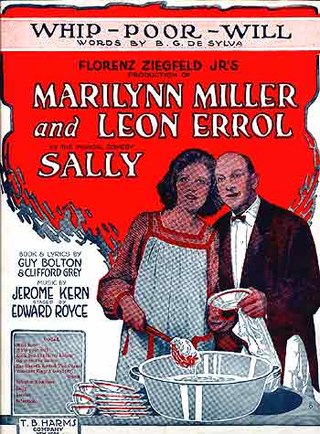
Sally is a musical comedy with music by Jerome Kern, lyrics by Clifford Grey and book by Guy Bolton, with additional lyrics by Buddy De Sylva, Anne Caldwell and P. G. Wodehouse. The plot hinges on a mistaken identity: Sally, a waif, is a dishwasher at the Alley Inn in New York City. She poses as a famous foreign ballerina and rises to fame through joining the Ziegfeld Follies. There is a rags to riches story, a ballet as a centrepiece, and a wedding as a finale. "Look for the Silver Lining" continues to be one of Kern's most familiar songs. The song is lampooned by another song, "Look for a Sky of Blue," in Rick Besoyan's satirical 1959 musical Little Mary Sunshine.

Rathausball-Tänze op. 438 is a waltz by composer Johann Strauss II written in 1890 in honour of the inauguration of the new city hall of Vienna. At the opening of the new banqueting hall (Festsaal) on 12 February 1890 two rival orchestras were commissioned to provide dance music for the occasion; the Strauss Orchestra under the direction of Eduard Strauss, and that of rival Kapellmeister Karl Michael Ziehrer who was head of the Vienna House Regiment 'Hoch und Deutschmeister No. 4'.

The Great Waltz is a 1938 American biographical film based very loosely on the life of Johann Strauss II. It starred Luise Rainer, Fernand Gravet (Gravey), and Miliza Korjus. Rainer received top billing at the producer's insistence, but her role is comparatively minor as Strauss' wife, Poldi Vogelhuber. It was the only starring role for Korjus, who was a famous opera soprano and played one in the film.

Waltzes from Vienna is a 1934 British biographical film directed by Alfred Hitchcock, sometimes known as Strauss' Great Waltz. It was part of the cycle of operetta films made in Britain during the 1930s.
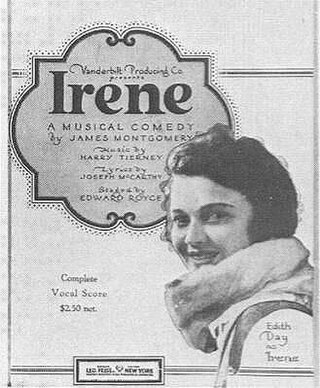
Irene is a musical with a book by James Montgomery, lyrics by Joseph McCarthy, and music by Harry Tierney. Based on Montgomery's play Irene O'Dare, it is set in New York City's Upper West Side and focuses on immigrant shop assistant Irene O'Dare, who is introduced to Long Island's high society when she is hired to tune a piano for a society gentleman.
"By Strauss" is a 1936 song composed by George Gershwin, with lyrics by Ira Gershwin. It pays homage to the music of Johann Strauss, Sr. and Johann Strauss, Jr.
Walter Reisch was an Austrian-born director and screenwriter. He also wrote lyrics to several songs featured in his films, one popular title is "Flieger, grüß mir die Sonne". He was married to the dancer and actress Poldi Dur and was the cousin of Georg Kreisler.
Walzer aus Wien is a singspiel pasticcio in three acts, libretto by Alfred Maria Willner, Heinz Reichert and Ernst Marischka, music by Johann Strauss II (son), arranged by Erich Wolfgang Korngold and Julius Bittner, first performed at the Stadttheater in Vienna on 30 October 1930.

Das Spitzentuch der Königin is an operetta by Johann Strauss II. The libretto by Heinrich Bohrmann-Riegen and Richard Genée was based on the Spanish writer Cervantes.
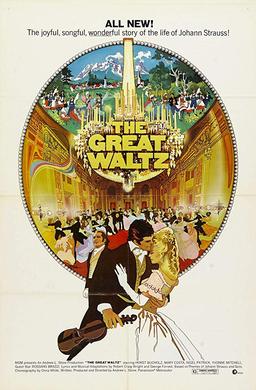
The Great Waltz is a 1972 American biographical musical film directed by Andrew L. Stone, and starring Horst Buchholz, Mary Costa, and Nigel Patrick, that follows 40 years in the life of composer Johann Strauss and his family. It is based on the musical The Great Waltz, and was Stone's final film. M-G-M released a previous film adaptation in 1938, which is about a different phase of the younger Strauss's life.

Make Mine Manhattan is a 1948 Broadway revue with music by Richard Lewine, lyrics by Hassard Short, and sketches by Arnold Horwitt and produced by Joseph Hyman.
The Strauss Dynasty is an Austrian biographical film in six parts from 1991. It depicts the careers of Johann Strauss (father), the composer of the Radetzky March, and his son Johann Strauss (son) ("Schani"), the composer of the waltz The Blue Danube, who, despite his father's resistance, also became a musician and competed with his father as a waltz composer.
The Great Waltz may refer to:
